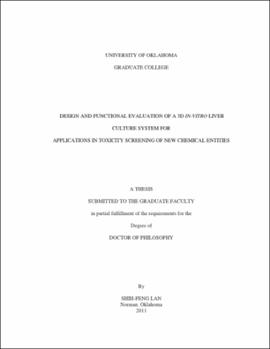| dc.contributor.advisor | Starly, Binil | |
| dc.creator | Lan, Shih-Feng | |
| dc.date.accessioned | 2019-04-27T21:24:33Z | |
| dc.date.available | 2019-04-27T21:24:33Z | |
| dc.date.issued | 2011 | |
| dc.identifier | 99162186802042 | |
| dc.identifier.uri | https://hdl.handle.net/11244/318612 | |
| dc.description.abstract | Advancements in biomaterials and manufacturing processes have enabled the development of 3D cell encapsulated hydrogels as systems to mimic in-vivo like function for drug-screening. Accurate prediction of human response to potential therapeutic drugs and vaccines are through conventional methods of in-vitro cell culture assays and expensive in-vivo animal testing. Traditional in-vitro cell culture assays are time consuming, at times unreliable and expensive. Hence, there is a critical need to reduce the time and financial investment required to discover new drug cures for major illnesses through advanced tissue model systems. In this study, we have evaluated the use of 3D culture with HepG2 liver cells for applications in drug testing. The method is based on alginate hydrogels encapsulation. Two different ultra-sterile alginates, SLM100 (G:M::40:60) and SLG100 (G:M::60:40) have been used for our 3D matrix. In addition, we present a disc design and dynamic device for 2D-3D co-culture and 3D dynamic culture. The major research accomplishments reported in this thesis include: | |
| dc.description.abstract | I.Development of the encapsulation method for 3D culture. We have studied the cellular viability and metabolic capacity of the encapsulated cells in two different alginate structures SLM100 and SLG100. We have also developed protocols to characterize the encapsulated cells within the alginate structure using Scanning Electron Microscopy (SEM) and Laser Scanning Confocal Microscopy (LSCM). Liver-specific enzymes such as CYP1A1 and CYP3A4 after 14 days in culture indicates the viability and functionality of the encapsulated HepG2 cells. Phase II Glutathione activity of the encapsulated cells were also maintained in 3D culture conditions. The encapsulated cells within the 3D gels were also capable of metabolizing the pro-drug EFC (7-ethoxy-4-trifluoromethyl coumarin) to HFC (7-hydroxy-4-trifluoromethyl) in a linear fashion over a period of time. | |
| dc.description.abstract | II.Development of the porous poly-carbonate disc platform for 3D culture. We have developed an in vitro platform to enable high density 3D culture of liver cells combined with a monolayer growth of target breast cancer cell line (MCF-7) in a static environment as a representative example of screening drug compounds for hepatotoxicity and drug efficacy. Alginate hydrogels encapsulated with serial cell densities of HepG2 cells (105-108cells/ml) are supported by a porous poly-carbonate disc platform and co-cultured with MCF-7 cells within standard cell culture plates during a 3 day study period. The clearance rates of drug transformation by HepG2 cells are measured using a coumarin based pro-drug. The platform was used to test for HepG2 cytotoxicity 50% (CT50) using commercially available drugs which further correlated well with published in vivo LD50 values. | |
| dc.description.abstract | III.Development of dynamic device for 3D culture. the design approach is (1) To design a liver bioreactor unit that is scalable, interchangeable and compatible with other scaffold materials; (2) To establish a long-term 3D culture dynamic environment; (3) compared the drugs toxicity result between dynamic and static. | |
| dc.description.abstract | The 3D encapsulation of cells within hydrogels represents an increasingly important and popular technique for culturing cells and towards the development of tissue engineering and drugs testing. This environment better mimics what cells live in vivo, compared to standard tissue culture, due to the tissue-like properties and 3D environment. The following methods for the 3D encapsulation of HepG2 have been optimized in our lab to maximize cell viability and liver specific enzymes activity, minimize the of hydrogel processing steps using support disc design and integrated into dynamic device. The research will also enable scientists to expand their scope of research and study in the field of in vitro drug screening and toxicity study. | |
| dc.format.extent | 149 pages | |
| dc.format.medium | application.pdf | |
| dc.language | en_US | |
| dc.relation.requires | Adobe Acrobat Reader | |
| dc.subject | Toxicity testing--In vitro | |
| dc.subject | Drugs--Toxicology | |
| dc.subject | Cell culture | |
| dc.title | DESIGN AND FUNCTIONAL EVALUATION OF A 3D IN-VITRO LIVER CULTURE SYSTEM FOR APPLICATIONS IN TOXICITY SCREENING OF NEW CHEMICAL ENTITIES | |
| dc.type | text | |
| dc.type | document | |
| dc.thesis.degree | Ph.D. | |
| ou.group | College of Engineering::Department of Engineering | |
